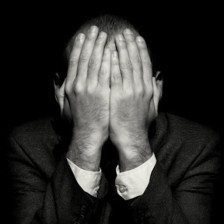Genetics of BDD
Recent research has shown that genetic factors are likely to play an important role in the etiology of BDD.
Eight percent of individuals with BDD have a family member with a lifetime diagnosis of BDD, which is four to eight times the prevalence in the general population.
BDD shares heredity with obsessive-compulsive disorder (OCD), as family studies have shown that 7% of BDD patients were found to have a first-degree relative with OCD, and first-degree relatives of OCD probands have a six times higher lifetime prevalence of BDD than do relatives of controls.
Functional Imaging in BDD
Recently, the first functional imaging study to compare BDD patients to controls examined visual information processing of faces, with respect to spatial frequency.
Twelve BDD patients and twelve healthy controls underwent functional magnetic resonance imaging (fMRI) while matching photographs of faces.
Some of the faces were digitally altered to remove the high or low spatial frequencies, which created images that contained configural or detail information, respectively.
BDD participants showed greater left hemisphere activity relative to controls for all face tasks, particularly in lateral aspects of the prefrontal cortex and the temporal lobe. They also activated dorsal anterior cingulate gyrus for the low spatial frequency (LSF) face task.
Controls, on the other hand, activated left-sided prefrontal cortex and dorsal anterior cingulate gyrus only for the high spatial frequency (HSF) face task.
Greater left-sided activity for LSF and normal faces suggests a predominance of detail encoding and analysis, a pattern evident in controls only for HSF faces. This suggests that BDD patients may process faces in a piecemeal manner, while healthy controls’ perception of faces may be more configural and holistic.
These laterality patterns in the BDD participants suggest a bias for local, or detail-oriented, processing of faces over global processing.
The results from these study suggest that BDD participants show fundamental differences from controls in visual processing, with different laterality of activation patterns in areas representing an extended visual processing network, and abnormal amygdala activation.
These abnormalities may be associated with BDD patients’ apparent perceptual distortions; they may focus in excruciating detail on specific facial features and lose the larger, overall context of the whole face.
As this experiment used others’ faces and not their own, it will be important for future studies to investigate the processing of their own faces as they may experience greater distortions and because of the possibility of the influence of emotional arousal.
Neuropsychology of BDD
Deficits in organizational strategies in BDD patients, who tended to use a strategy of focusing on details rather than recalling the overall organization and properties of visual stimuli or verbal information,
Other studies have shown that BDD patients exhibit selective processing of threat and distraction by emotional cues, similar to patients with anxiety disorders
These data demonstrate that BDD patients are vulnerable to distraction by emotional cues in general, and by words and situations related to their current concerns in particular.
These patterns of cognitive and emotional processing suggest that BDD may be related to anxiety disorders such as social phobia.





Have you successfully cured your BDD yet? Or is this a lifelong disease?
Hi John,
BDD is definitely a lifelong disease, as of now though I feel as like I am “in recovery”. Have been back to enjoying many of the activities that I found difficult over the last 2 years. Have been more involved and eager to attend social activities and feeling a bit less self conscious. I say “less” because the cloud of BDD is always there hanging over me. Hopefully this year I will make the time to finally get into therapy, I feel like this has been the missing component for some time. I am so busy with work, and kids and my business pursuits that if I have a moment I would rather take an hour and a half and hit the trail for run or go for a bike ride. And this is my therapy. But these are just excuses and this year has to be the time I make the leap.
Thanks for your comment!
Stephen